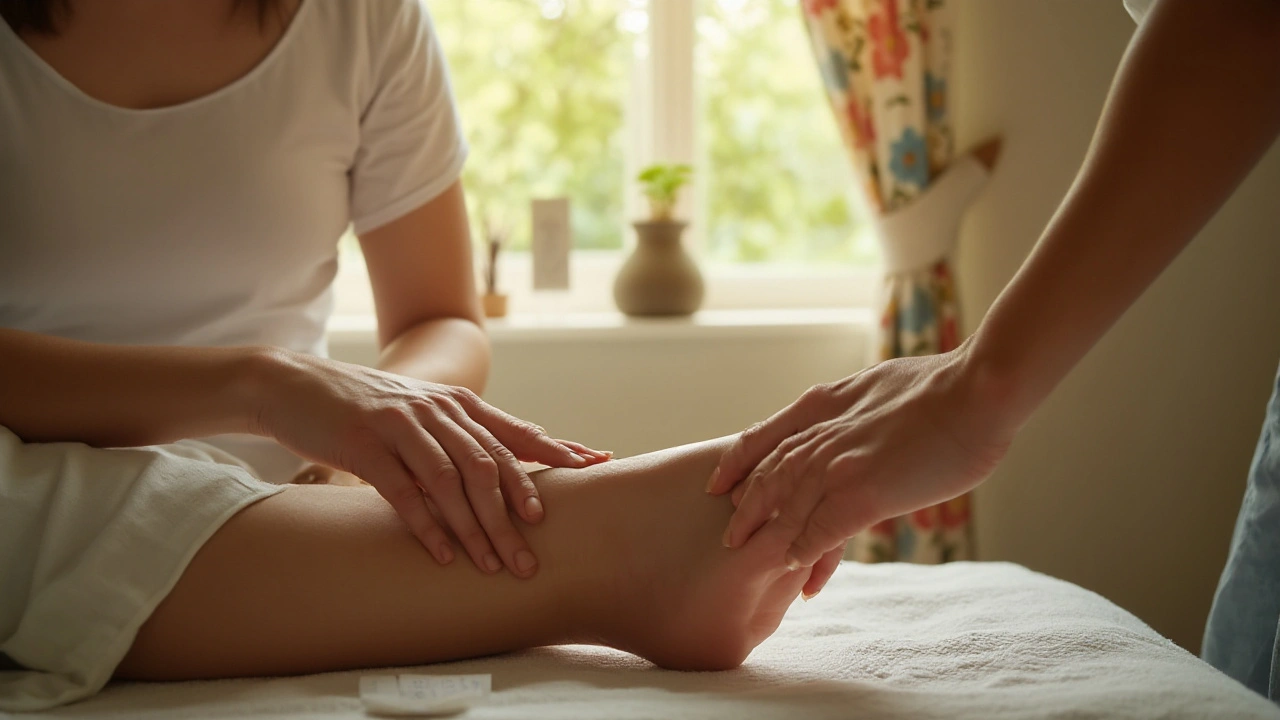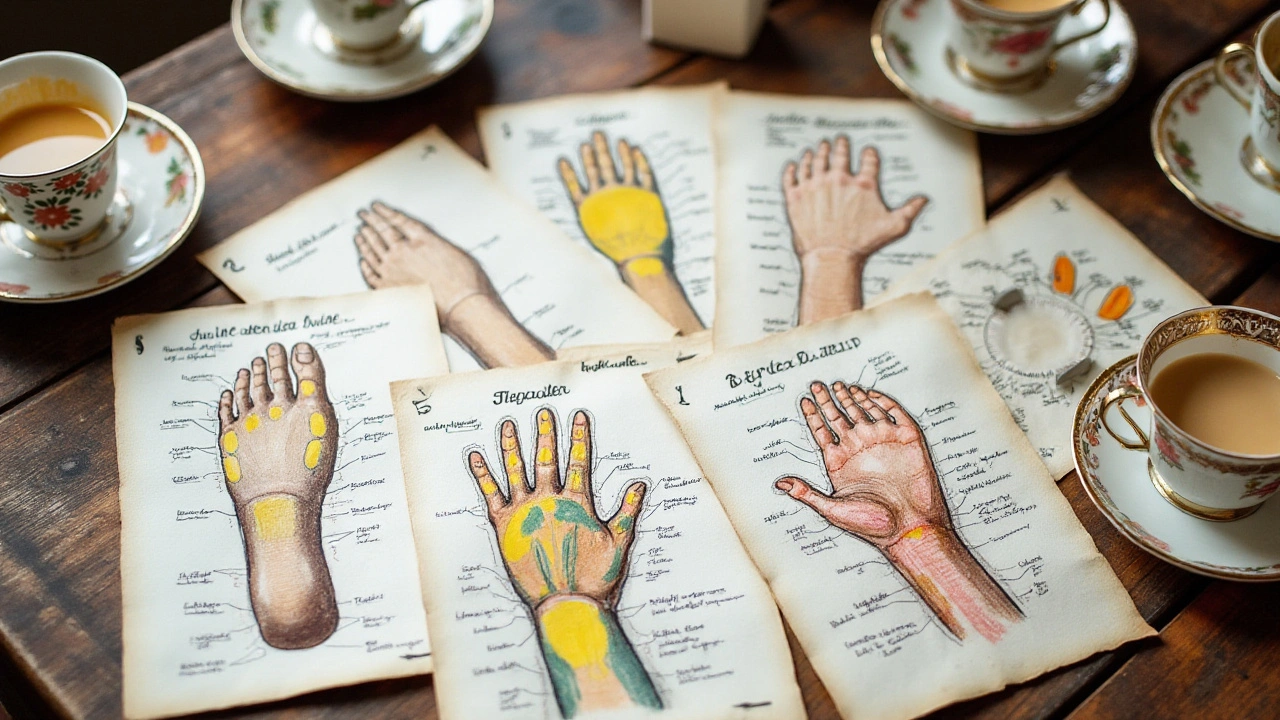Natural Pain Relief with Reflexology Techniques
 Oct, 6 2024
Oct, 6 2024
Imagine a form of therapy that doesn't rely on pills or injections, yet offers relief from aches and chronic pain. That's where reflexology comes into play. This age-old practice centers around the idea that our feet, hands, and ears are more than just physical appendages—they are detailed maps of our entire bodies.
The beauty of reflexology lies in its simplicity. By applying gentle pressure to specific areas, it's believed that energy blocks are cleared, promoting balance and well-being. People from many cultures have turned to this method for its potential to ease discomfort and improve quality of life. Whether you're new to reflexology or on a journey to dive deeper, understanding this practice can open doors to a holistic approach to health.
- Understanding Reflexology
- How Reflexology Alleviates Pain
- Benefits and Limitations
- Scientific Studies and Anecdotal Evidence
- Getting Started with Reflexology
Understanding Reflexology
Reflexology, at its essence, is an alternative therapy that dates back thousands of years, with roots tracing to ancient civilizations like Egypt and China. This practice hinges on the premise that specific areas, or reflex points, in the feet, hands, and ears relate to organs and systems within the body. By skillfully applying pressure to these points, reflexologists aim to encourage healing and promote relaxation across one's entire being. Reflexology's allure lies in its non-invasive nature, giving people a therapeutic option without the need for medical interventions.
The artistry of reflexology is understanding the detailed map that corresponds to the body's internal and external structures. For example, the big toe is thought to be linked to the head, whereas the arch might correspond to digestive organs. Each foot represents a half of the body, providing a mirrored map that therapists use for guidance. A fascinating aspect is how these points, when stimulated correctly, can have a profound impact on health, enabling energy to flow freely and potentially alleviating stress, tension, pain, and even emotional blockages.
An interesting fact that many might not know is that reflexology has made its way into numerous modern health practices, sometimes offered alongside traditional treatments. Pain management clinics, hospices, and even maternity wards now consider reflexology as a supplement to conventional treatments. A quote from the esteemed Mayo Clinic encapsulates this well:
"Reflexology can be a helpful tool in managing stress and promoting relaxation, which contributes to an individual's overall well-being."Practitioners believe that as pressure is applied, it might clear pathways, allowing life force or 'Qi' to circulate, which in turn contributes to the body's ability to heal itself naturally.
Reflexology also distinguishes itself from general foot massage with its specialized focus and intent. While a foot massage resembles a soothing spa treatment, reflexology targets specific points to conjure therapeutic benefits. It often involves a specific sequence tailored to each person's particular health needs. Engaging with reflexology invites a deeper understanding and appreciation of the body's innate ability to maintain balance and harmony. Reflexology not only draws from historical knowledge but continues to evolve, with modern practitioners developing new techniques and understanding through both experience and ongoing research.
How Reflexology Alleviates Pain
Reflexology is a fascinating practice when it comes to pain relief. It works on the principle that specific points on the feet, hands, and ears relate directly to organs and systems throughout the body. By applying pressure to these reflex points, reflexologists believe they positively impact these areas, promoting not only relaxation but also pain mitigation. Many people report a tingling sensation or warmth as the reflex points are activated, suggesting a flow of energy being redirected or stimulated. This process helps to ease tension, improve circulation, and encourage the body's own healing processes, thus alleviating pain.
For those grappling with chronic pain, such as back pain or migraines, reflexology offers a unique reprieve. The technique can act as a reset button for the body's nervous and circulatory systems. By focusing on the pressure points, the therapy aims to unblock nerve impulses and help blood flow unimpeded. This facilitates the delivery of vital nutrients and oxygen to cells, enhancing their function and potentially reducing the sensation of pain. Additionally, reflexology encourages the production of endorphins, the body's natural painkillers, which can enhance mood and give a sense of overall well-being.
Specific techniques used in reflexology include the thumb and finger walking method, which involves rhythmically pressing and moving along the zones of the feet and hands. There's also the hook and back-up technique, which precisely targets areas contributing to a client’s pain. These methods are gentle yet profound, offering a dynamic yet non-invasive path to pain management. Modulations in pressure can even help discern varying levels of sensitivity, guiding the reflexologist in tailoring the session to specific needs. By targeting these key areas, clients can find relief from their ailments and uncover a pathway to healing that aligns with the body's own rhythms.
Various studies have explored the impact of reflexology on pain, with positive outcomes. For instance, a study published in the Journal of Pain Management found that reflexology can significantly reduce pain and anxiety in cancer patients.
Dr. Carol Weyland Conner states, “Reflexology helps balance the system, and when the body is in balance, healing occurs.”While not a cure-all, reflexology presents a compelling case as part of a comprehensive pain management strategy.

Benefits and Limitations
When considering the practice of reflexology, it's essential to take a closer look at both its benefits and its limitations. Reflexology is cherished by many for its non-invasive approach to pain relief. As the world increasingly seeks natural alternatives to chemical treatments, reflexology presents itself as an intriguing option. Among its touted benefits is an enhancement in circulation. By applying pressure to specific points, practitioners believe that blocked energy pathways are opened, allowing for better blood flow and resulting in quicker healing times. This improved circulation is also believed to bring about a detoxifying effect, encouraging the body's natural processes to eliminate waste products more efficiently.
Another significant benefit claimed by advocates is its ability to reduce stress. In a world constantly on the move, everyone is susceptible to stress and anxiety. Reflexology, with its soothing touch, offers an escape from daily pressures. It's said to trigger the release of endorphins, the body's natural 'feel-good' chemicals, which help in promoting relaxation and a sense of well-being. Additionally, those with specific health conditions, like migraines, digestive disorders, and even hormonal imbalances, have sought relief through reflexology, and there is anecdotal evidence suggesting positive outcomes.
Despite these potential benefits, reflexology isn't without its limitations. It's important to approach this therapy with a realistic mindset. While it's an excellent complementary method to traditional medicine, it should never replace conventional medical treatment, particularly for serious health issues. One of the challenges is the lack of comprehensive scientific evidence to back the numerous positive testimonials. Scientific studies on reflexology remain limited in number and scale, leading to debates within the medical community about its effectiveness.
According to the British Reflexology Association, "Reflexology is a safe, non-invasive therapy that supports wellbeing. It works alongside conventional healthcare to promote better health."
Additionally, practitioners might vary in their techniques and proficiency. This variability can result in inconsistent experiences and outcomes for clients. Furthermore, not everyone is a suitable candidate for reflexology. Those with certain foot conditions or injuries, severe heart problems, or conditions like deep vein thrombosis should exercise caution and seek professional medical advice before undergoing sessions. Having a thorough understanding of these aspects can help individuals make informed decisions about incorporating reflexology into their health routines. Always remember, as with any health practice, it's essential to consult with a healthcare professional to assess individual circumstances.
Scientific Studies and Anecdotal Evidence
Reflexology has intrigued researchers and practitioners alike, prompting a closer look through scientific studies to validate the claims made by its proponents. While the scientific community approaches this field with cautious curiosity, some studies have suggested a connection between reflexology and measurable improvements in pain management. For instance, a study conducted by the University of Portsmouth found that participants who underwent reflexology treatments reported a significant reduction in feeling pain compared to those who did not. This study hinted at the possibility that reflexology has a promising place in the field of complementary therapies.
However, the story doesn't end there. Many accounts extend beyond the confines of formal research and delve into the realm of personal experience. People around the world have shared their personal anecdotes of how reflexology has eased their chronic pain, increased their energy levels, or even alleviated severe headaches. Anecdotal evidence reflects a wide array of positive outcomes, often emphasizing the holistic nature of this practice, which tends to treat an individual as a whole rather than just targeting specific symptoms.
"Reflexology made a monumental difference in managing my pain levels," shared Emily Watson, a chronic pain sufferer. "The relief wasn't just physical but emotional too, lifting my spirits immensely."
The divergence between scientific studies and personal anecdotes is not uncommon in alternative medicine. This gap often leads to intriguing conversations about the nature of healing and the role of perception in experiencing relief. Despite varying levels of acceptance in the scientific community, the enthusiasm for natural solutions like reflexology persists among many, fueled not just by isolated instances of success but by centuries of traditional use.
While skepticism remains, especially considering the placebo effect, the growing body of research invites ongoing exploration. For instance, a review published in Complementary Therapies in Clinical Practice assessed that reflexology contributed to pain relief and improved mental health to a certain degree. While not universally accepted as conclusive, these findings offer encouraging, albeit cautious, support for the practice's role. Ultimately, the journey of reflexology continues as scientists and practitioners seek to balance tradition with empirical evidence, offering a fascinating glimpse into the convergence of art and science in the realm of healing.

Getting Started with Reflexology
Diving into the world of reflexology can be an exciting journey, one that promises a deeper connection to your body's natural healing abilities. The beauty of this artful practice is how accessible it is for everyone, regardless of age or physical ability. Before you begin, it’s helpful to understand the basic principles which assert that specific areas on your feet, hands, and even ears correspond to different organs and systems within your body. These reflex points, when massaged or pressed, are believed to improve energy flow and relieve pain.
To start practicing reflexology, it’s essential to familiarize yourself with a reflexology chart. These charts act like maps, showing you which parts of the foot or hand relate to certain body parts. At first glance, it might seem a little overwhelming, but with some patience and practice, you'll soon find it intuitive. There’s no need to rush; learning to press the right points is an art that can be perfected over time. As you practice, you become more attuned to the signals your body sends, and your sensitivity increases.
Investing in a few basic tools can enhance your reflexology experience. Soft touch rollers, reflexology balls, or specialized sticks can help you apply steady pressure to precise points, ensuring each session is effective and enjoyable. Most importantly, always approach each session with a sense of serenity. Set aside a quiet, comfortable space and use soothing music to create an ambiance that encourages relaxation. If practicing reflexology on others, remember to communicate openly, ensuring the pressure applied is neither too soft nor too hard, striking the right balance for optimal healing.
For those who prefer guided support, booking a session with a professional reflexologist can be incredibly insightful. Speaking with Deirdre McCabe, a renowned reflexologist, sheds light on the practice:
"Reflexology isn’t just about pressing points; it’s about listening to the body. It's a partnership between the practitioner and the client's energy."Her words highlight the importance of intuition and understanding in every step of the process, encouraging a personalized approach to health and wellness.
If you have any medical concerns or are pregnant, it’s wise to consult with your doctor before starting any complementary therapies, including reflexology. While this practice is generally safe, certain pressure points might be contraindicated during pregnancy or for individuals with special health conditions. Starting with a professional who can guide you, especially if you're new to the practice, might also be a prudent choice.
Practicing regularly is key to unlocking the many benefits of reflexology. With time, you might find not only relief from physical pain but also improvements in mood, energy levels, and a deeper sense of relaxation. As you explore reflexology, let it be a gentle reminder of the incredible power our bodies possess to heal and regenerate naturally.
